A possible scenario could be a joint Sino-Pakistan attempt to try and detach Ladakh UT from the rest of India.
Earlier on 23 May, this writer had warned the Chinese in the 70th year of relations between India and the PRC not to repeat the error made by Jawaharlal Nehru and B.N. Mullick in 1962, which was to assume that China would not fight despite the steady nibbles of territory labelled as our “forward policy”. On 20 October, that surmise was shown to be incorrect, when PLA troops poured across the boundaries of India. In May 2020, when the PLA moved in force into territory that had never been questioned by Beijing as anything other than belonging to India, it was as the latest move in a long chain of “forward policy” moves that have progressively whittled away at Indian territory. This was especially marked during the A.B. Vajpayee and Manmohan Singh periods. On the night of 15 June, the PLA realised the assumption that the Indian Army would not be permitted to respond in force was wrong. The question is: what is the strategy of the PLA? What is driving the CMC (Central Military Commission) into actions that threaten to derail commercial and other ties with India for a generation, a situation that would hurt China even more than it would India? The Lutyens Zone is habituated to thinking and acting within deep-set grooves that by now are well understood by other major powers. This may not include Pakistan, where GHQ Rawalpindi relies on glands rather than brains for working out its tactics, but almost certainly does China. Under General Secretary Xi Jinping, a team of 21st century minds has been assembled that exhibit considerable versatility despite the constraints imposed by the need to function within the four corners of standard Chinese Communist Party theory and practice.
Xi Jinping’s Brains Trust has long been aware that an existential battle is being waged between the CCP and the United States. Should the Chinese economy stagger towards a rate of annual GDP growth of 3% or less, resulting social tensions are anticipated (by planners in capitals anxious at the possibility of China emerging as the globe’s top economy) to effectively fracture the country back towards the warlord era of the previous 125 years. In other words, the expectation among those planning the downsizing of the Chinese economy is that the CCP and therefore the PRC would not be around to celebrate its centenary in 2049. What took place in the USSR by 1992 is planned to be repeated with China, and a declining economy and military humiliation are at the core of such a strategy.
Given such a scenario, some within the PLA may have reached the conclusion that a conflict with India is very much a possibility, and that therefore conditions need to be created as would so weaken India that a kinetic response to PLA moves would be impossible. The embedding of GHQ Rawalpindi brass (including Inter-Services Intelligence staff) into the policy core of the Chinese military indicates that a joint tactical plan is now being worked out for India. A possible scenario could be a joint Sino-Pakistan attempt to try and detach Ladakh UT from the rest of India. It is not outside the realm of probability that GHQ Rawalpindi may have offered control over the Ladakh segment to China, while keeping the Valley for itself after such a campaign. To buttress their appeal to the CCP leadership that such a policy of irreversible hostility between China and India is necessary, PLA planners may be passing on the occasional statements on retaking Aksai Chin made by Indian ruling party politicians and retired military personnel (in China a concept such as “retirement” does not exist, so far as views expressed publicly by former PLA officers are concerned). Aware of the seriousness with which the Chinese take words and statements uttered in India, even those made solely with an eye on domestic constituencies, this writer has never spoken of taking back Aksai Chin, the territory lost through the negligence of the Government of India in the 1950s. However, such is not the case with PoK, which must be recovered. That territory is as important strategically for India as Aksai Chin is to China, especially given the nature of the situation in Xinjiang and Tibet. However, acceptance of the LAC as the border would hinge on the Chinese avoiding the trap laid for them in Ladakh by Pakistan army advisors. The Chinese “new forward policy” on the border with India leads to a quagmire and a de facto rupture of relations with India.
While it may be unrealistic to believe that Russia would stand by India against China in such a conflict, the US would find it to its advantage to ensure that India prevails militarily and economically over a Sino-Pakistan axis. Washington would, along with capitals such as Tokyo, London and Canberra, oppose PLA-GHQ moves that seek to detach Ladakh UT from the rest of our country. The military in India is strong enough to render such an effort disastrous for the attackers, should the PLA be lured so deeply into the Kashmir trap of GHQ Rawalpindi.
At the same time as responding across the board to Chinese incursions of the LAC, innovative diplomacy needs to be initiated to try and ensure that President Xi Jinping distances CCP policy from the disastrous policy options being promoted by GHQ Rawalpindi to the PLA. Fast-track settlement of the boundary issue by making the LAC the legal border would be in the best interests of not just India but China.

